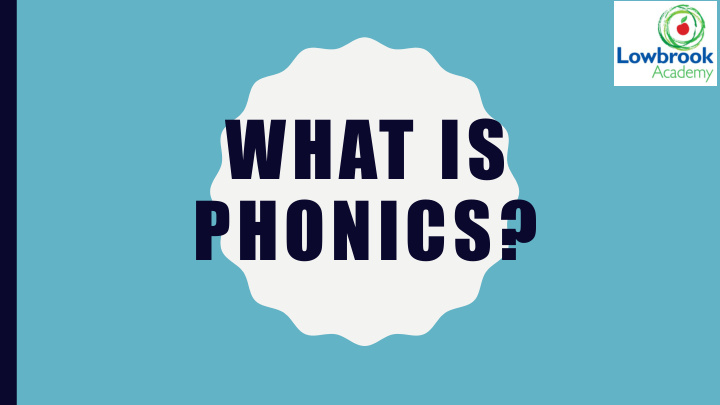



WHAT IS PHONICS?
Aims of Today… To share with you how phonics is taught in Lowbrook’s Early Years Foundation Stage. To suggest ways you can help your children at home. To share resources, practical ideas and websites. To explain how we teach high frequency words / tricky words
What scheme do we use at Lowbrook? We follow the Letters and Sounds programme. Letters and Sounds is a phonics resource published by the Department for Education and Skills which consists of six phases. We run the Letters and Sounds programme alongside Jolly Phonics which is very visual and practical, and works well within Phases 2 to 5 of Letters and Sounds.
Ev Everyt ything hing star arts ts with th readin ding! ! Being able to read is the most important skill children will learn during their early schooling and has far-reaching implications for lifelong confidence and well-being.
Why Teach Phonics? It is proven that high quality daily phonics teaching secures the skill of word recognition. Once mastered, most children are able to read fluently and automatically. Once children are fluent readers, they are able to concentrate on the meaning of the texts that they read. Children can then move from learning to read to reading for pleasure and purpose. Phonics also teaches skills for spelling and therefore improves standards in a child’s writing, as well as improving general academic performance.
What is Phonics? Phonics is the link between letters and the sound they make. Using a highly structured programme working through 6 progressive phases, children are taught: The full range of common letter / sound correspondences To hear separate sounds within words. To blend sounds together.
Some definitions Phoneme: The smallest unit of sound in a word. Grapheme: The graphical representation of a sound/phoneme - what the sound looks like when it’s written. For some phonemes, this could be more than one letter, e.g. ai, igh Digraph: A phoneme represented by two letters which make one sound, e.g. sh tk ch Trigraph: A phoneme represented by three letters that make one sound. CVC: Consonant, vowel, consonant. Segmenting: Breaking up a word into its sounds.
Phase 1 Showing awareness of rhyme and alliteration. Distinguishing between sounds they hear. Exploring and experimenting with words and sounds. Orally blend and segment.
Phase 2 Using common consonants and vowels. Blending for reading and segmenting for spelling. Understanding that words are made from sounds and that sounds are represented by letters.
Phase 2 Although some children will have been introduced to the first 6 sounds (SATPIN) at nursery/pre-school, Phase 2 introduces 19 grapheme-phoneme- correspondences (GPCs) in total. As soon as children have learnt a small number of grapheme/phoneme correspondences, blending and segmenting can begin.
Phase 2 Sounds in the order they are taught…
Phase 2 High frequency words - words which occur most frequently in written material, for example, "and", "the", "as" and "it". They are often words that have little meaning on their own, but they do contribute a great deal to the meaning of a sentence.
Phase 2 Tricky words - words which cannot be sounded out correctly using the taught phonics sounds. The only way these words can be read and spelt correctly is by learning them and having plenty of practice. Each week, the children learn high frequency and tricky words – these are the red words in their homework books.
Phase 3 Reading and spelling a range of CVC words. Using all the letters and consonant digraphs (ch, sh, ng, th). Using long and short vowel phonemes.
Phase 3 Sounds in the order they are taught…
Phase 3 High frequency words - words which occur most frequently in written material, for example, "and", "the", "as" and "it". They are often words that have little meaning on their own, but they do contribute a great deal to the meaning of a sentence.
Phase 3 Tricky words - words which cannot be sounded out correctly using the taught phonics sounds. The only way these words can be read and spelt correctly is by learning them and having plenty of practise. Each week, the children learn high frequency and tricky words – these are the red words in their homework books.
Phase 4 This is a consolidation unit. There are no new sounds to learn. Reading and writing of tricky words continue. More focus on CVCC and CCVC words.
Phase 5 Reading phonetically decodable two- syllable and three- syllable words. Using alternative ways of pronouncing and spelling sounds.
Phase 6 Applying phonic skills and knowledge to recognise and spell an increasing number of complex words. Recognising phonics irregularities and becoming more secure with less common grapheme-phoneme correspondences. Introducing and teaching the past tense. Investigating and learning how to add suffixes.
Apps and Websites www.phonicsplay.co.uk www.educationcity.co.uk www.ictgames.com/literacy http://www.bbc.co.uk/bitesize/k s1/literacy/phonics/play/popup.s html Missy ABC app Phonics with Letter Lilies app ABC PocketPhonics app Funimal Phonics app Hairy Letters app
Recommend
More recommend